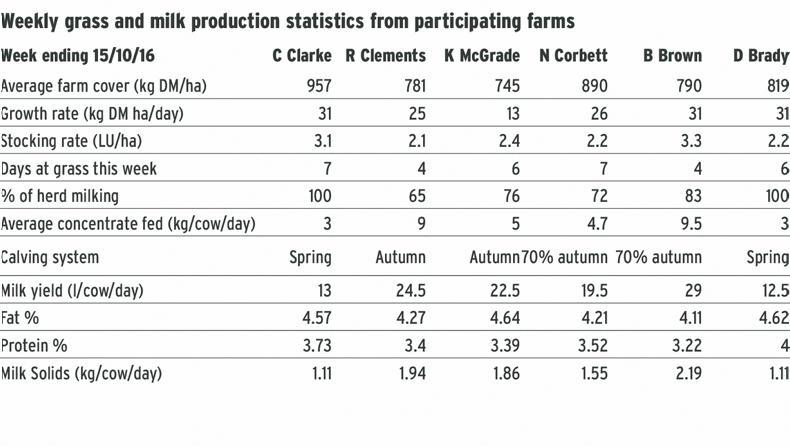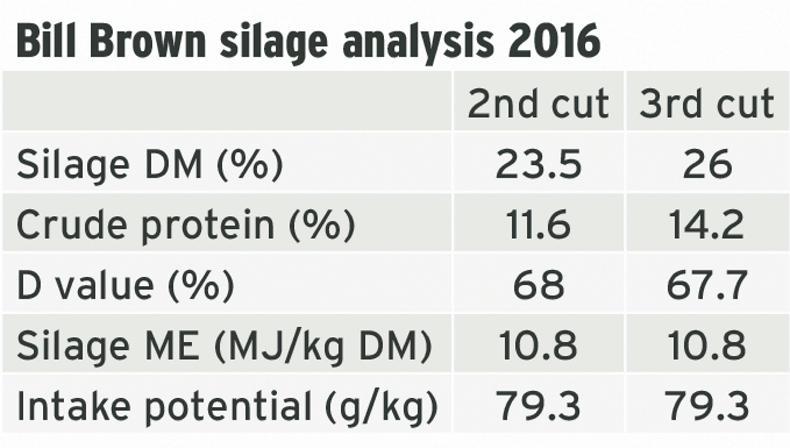This year, I have spent some time analysing herd performance each month and it is clear to see in which month the Dairylink herds can generate the highest margin.
Generally, herds are most profitable when grazing grass, so from April through to October are the highest-margin months for farms.
In general, March to May generates the highest net margin per farm.
Historical performance data for previous years highlights that increased per cow yields has taken 1.1kg of purchased feed for each additional litre produced.
Overhead cost
At today’s feed prices, this has an approximate cost of about 22ppl. Therefore, the argument that extra litres help to dilute overhead cost per litre does not hold for me.
In many cases, the additional litres cost more to produce in feed cost alone at current milk prices, never mind labour and all the other related costs.
For many farms, the focus over the past few years has been to increase farm output. With genetics and feeding, farmers have achieved this.
However, farm margins have not increased. In fact, they have reduced. Lowering feed cost per litre and improved production from grazed grass with quality forage will be the key areas for businesses moving forward.
Farmer focus: Bill Brown, Millisle, Co Down
The past weekend has started the winter routine on our farm here in Millisle, Co Down, with the cows in at night and out grazing during the day. For freshly calved cows, I want to maintain body condition as much as I can and getting the cows to graze paddocks well is nearly impossible, even after attempting to build an appetite prior to turnout in the morning.
During the night, we only put out enough feed to get cows to 4am/5am, which means cows have three hours without feed before going back to grass.
There are 140 cows milking, with 105 calved since 20 August, while the other 35 are late spring-calving cows. I plan to keep the late spring cows milking and outside for another month. The remaining cows will move inside night and day over the next fortnight.
Currently, the 140 cows are producing an average daily milk output of 29 litres, with 9.5kg of concentrate going in via the parlour and the wagon.
We are debating whether to split this group of fresh cows into two groups.
If we do that, we would put 50 high-yielders into a group and keep them inside day and night and feed them to yield averaging about 10kg of meal per cow.
This would allow us pull the rest of the lower-yielding fresh cows into another group and feed them slightly less meal.
At the moment, we are using over 1t of meal per day and we need to look at how we can deliver this more efficiently and reduce over quantity purchased.
Dry cows are managed in groups. Effectively, all cows due to calve in November are in one group and the same for December. The main reason for this is to monitor body condition and ensure cows are getting minerals.
Cows get a bolus (£5.50/head) and two weeks pre-calving, cows are moved inside and on to a silage/hay diet, with pre-calving minerals dusted on top of the feed at a rate of 150g/head.

Current winter feeding plan
This year, cows have been out longer at grass. The average cover on the platform is 790kg DM/ha and we still have a few paddocks with high covers in excess of 1,700kg available grass (3,200kg total cover).
We started to close the first paddock on 3 October.
The main milking block of freshly calved cows (currently 105) will have to be housed full time within the next 10 days. I will use dry stock to finish grazing on the platform if required.
Currently, we are feeding second-cut silage, which was a very heavy crop this year and consequently my lowest-quality silage, but we need to use this silage first to allow access to the better first-cut.
While the energy level of the silage is fine, the grass digestibility and intake potential is lower than expected, which is effectively lowering the total dry matter intake.
Diet formulation
The base diet for the freshly calved cows is formulated to deliver cow maintenance plus 15 litres. Currently, a mixture of silage and 2kg of blend will deliver sufficient energy to sustain cow maintenance plus 9l of milk.
The contribution from grazed grass is estimated at only 3kg DM/cow from daytime grazing providing sufficient energy for 6l. This is a total of 15l from the base diet and daytime grazing.
Additional concentrate is allocated in the parlour and through out-of-parlour feeders, both of which are set up with feed to yield and cows yielding above 15l receive concentrate at 0.45kg/litre above 15l allocated on a 70/30 split between the parlour/out-of-parlour feeders.
The protein target within the diet this year has been set at 16.8% for freshly calved cows with more emphasis placed on energy intake this year.

This year, I have spent some time analysing herd performance each month and it is clear to see in which month the Dairylink herds can generate the highest margin.
Generally, herds are most profitable when grazing grass, so from April through to October are the highest-margin months for farms.
In general, March to May generates the highest net margin per farm.
Historical performance data for previous years highlights that increased per cow yields has taken 1.1kg of purchased feed for each additional litre produced.
Overhead cost
At today’s feed prices, this has an approximate cost of about 22ppl. Therefore, the argument that extra litres help to dilute overhead cost per litre does not hold for me.
In many cases, the additional litres cost more to produce in feed cost alone at current milk prices, never mind labour and all the other related costs.
For many farms, the focus over the past few years has been to increase farm output. With genetics and feeding, farmers have achieved this.
However, farm margins have not increased. In fact, they have reduced. Lowering feed cost per litre and improved production from grazed grass with quality forage will be the key areas for businesses moving forward.
Farmer focus: Bill Brown, Millisle, Co Down
The past weekend has started the winter routine on our farm here in Millisle, Co Down, with the cows in at night and out grazing during the day. For freshly calved cows, I want to maintain body condition as much as I can and getting the cows to graze paddocks well is nearly impossible, even after attempting to build an appetite prior to turnout in the morning.
During the night, we only put out enough feed to get cows to 4am/5am, which means cows have three hours without feed before going back to grass.
There are 140 cows milking, with 105 calved since 20 August, while the other 35 are late spring-calving cows. I plan to keep the late spring cows milking and outside for another month. The remaining cows will move inside night and day over the next fortnight.
Currently, the 140 cows are producing an average daily milk output of 29 litres, with 9.5kg of concentrate going in via the parlour and the wagon.
We are debating whether to split this group of fresh cows into two groups.
If we do that, we would put 50 high-yielders into a group and keep them inside day and night and feed them to yield averaging about 10kg of meal per cow.
This would allow us pull the rest of the lower-yielding fresh cows into another group and feed them slightly less meal.
At the moment, we are using over 1t of meal per day and we need to look at how we can deliver this more efficiently and reduce over quantity purchased.
Dry cows are managed in groups. Effectively, all cows due to calve in November are in one group and the same for December. The main reason for this is to monitor body condition and ensure cows are getting minerals.
Cows get a bolus (£5.50/head) and two weeks pre-calving, cows are moved inside and on to a silage/hay diet, with pre-calving minerals dusted on top of the feed at a rate of 150g/head.

Current winter feeding plan
This year, cows have been out longer at grass. The average cover on the platform is 790kg DM/ha and we still have a few paddocks with high covers in excess of 1,700kg available grass (3,200kg total cover).
We started to close the first paddock on 3 October.
The main milking block of freshly calved cows (currently 105) will have to be housed full time within the next 10 days. I will use dry stock to finish grazing on the platform if required.
Currently, we are feeding second-cut silage, which was a very heavy crop this year and consequently my lowest-quality silage, but we need to use this silage first to allow access to the better first-cut.
While the energy level of the silage is fine, the grass digestibility and intake potential is lower than expected, which is effectively lowering the total dry matter intake.
Diet formulation
The base diet for the freshly calved cows is formulated to deliver cow maintenance plus 15 litres. Currently, a mixture of silage and 2kg of blend will deliver sufficient energy to sustain cow maintenance plus 9l of milk.
The contribution from grazed grass is estimated at only 3kg DM/cow from daytime grazing providing sufficient energy for 6l. This is a total of 15l from the base diet and daytime grazing.
Additional concentrate is allocated in the parlour and through out-of-parlour feeders, both of which are set up with feed to yield and cows yielding above 15l receive concentrate at 0.45kg/litre above 15l allocated on a 70/30 split between the parlour/out-of-parlour feeders.
The protein target within the diet this year has been set at 16.8% for freshly calved cows with more emphasis placed on energy intake this year.









 This is a subscriber-only article
This is a subscriber-only article












SHARING OPTIONS: